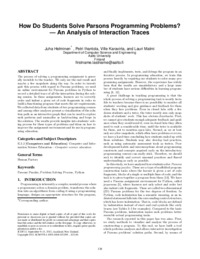How do students solve parsons programming problems?an analysis of interaction traces
Publikationsdatum:
Zu finden in: ICER 2012 (Seite 119 bis 126), 2012
|
 |
 Diese Seite wurde seit 4 Jahren inhaltlich nicht mehr aktualisiert.
Unter Umständen ist sie nicht mehr aktuell.
Diese Seite wurde seit 4 Jahren inhaltlich nicht mehr aktualisiert.
Unter Umständen ist sie nicht mehr aktuell.
 Zusammenfassungen
Zusammenfassungen
The process of solving a programming assignment is generally invisible to the teacher. We only see the end result and maybe a few snapshots along the way. In order to investigate this process with regard to Parsons problems, we used an online environment for Parsons problems in Python to record a detailed trace of all the interaction during the solving session. In these assignments, learners are to correctly order and indent a given set of code fragments in order to build a functioning program that meets the set requirements. We collected data from students of two programming courses and among other analyses present a visualization of the solution path as an interactive graph that can be used to explore such patterns and anomalies as backtracking and loops in the solution. The results provide insights into students' solving process for these types of problems and ideas on how to improve the assignment environment and its use in programming education.
 Dieses Konferenz-Paper erwähnt ...
Dieses Konferenz-Paper erwähnt ...
 Personen KB IB clear | Anthony Allevato , Alison Clear , Paul Denny , Stephen H. Edwards , Colin J. Fidge , Patricia Haden , Matthew C. Jadud , Dongkwan Kim , Michael Lance , Raymond Lister , Mike Lopez , Andrew Luxton-Reilly , Dale Parsons , Manuel A. Pérez-Quiñones , Phil Robbins , Ma. Mercedes T. Rodrigo , Amitrajit Sakar , Beth Simon , Jason Snyder , Emily S. Tabanao , Grace Tan , Donna Teague , Betsy Tretola , Anne Venables , Jacqueline L. Whalley | ||||||||||||||||||||||||||||||||||||||||||||||||||||||||||||||||||||||||||||||||||||||||||
 Begriffe KB IB clear | Parsons ProblemeParsons Problems
,  Programmieren Programmieren programming programming
| ||||||||||||||||||||||||||||||||||||||||||||||||||||||||||||||||||||||||||||||||||||||||||
 Bücher |
| ||||||||||||||||||||||||||||||||||||||||||||||||||||||||||||||||||||||||||||||||||||||||||
 Texte |
|
 Zitationsgraph
Zitationsgraph
 Zitationsgraph (Beta-Test mit vis.js)
Zitationsgraph (Beta-Test mit vis.js)
 Zeitleiste
Zeitleiste
 9 Erwähnungen
9 Erwähnungen 
- Koli Calling 2012 - 12th Koli Calling International Conference on Computing Education Research, Koli Calling '12, Koli, Finland, November 15-18, 2012 (Mikko-Jussi Laakso, Robert McCartney) (2012)
- A mobile learning application for parsons problems with automatic feedback (Ville Karavirta, Juha Helminen, Petri Ihantola) (2012)


- A mobile learning application for parsons problems with automatic feedback (Ville Karavirta, Juha Helminen, Petri Ihantola) (2012)
- Koli Calling 2013 - 13th Koli Calling International Conference on Computing Education Research, Koli Calling '13, Koli, Finland, November 14-17, 2013 (Mikko-Jussi Laakso, Simon) (2013)
- How to study programming on mobile touch devices - interactive Python code exercises (Petri Ihantola, Juha Helminen, Ville Karavirta) (2013)


- How to study programming on mobile touch devices - interactive Python code exercises (Petri Ihantola, Juha Helminen, Ville Karavirta) (2013)
- ICER 2014 - International Computing Education Research Conference, ICER 2014, Glasgow, United Kingdom, August 11-13, 2014 (Quintin I. Cutts, Beth Simon, Brian Dorn) (2014)
- Proceedings of the Workshop in Primary and Secondary Computing Education, WiPSCE 2015, London, United Kingdom, November 9-11, 2015 (Judith Gal-Ezer, Sue Sentance, Jan Vahrenhold) (2015)
- ICER 2015 - Proceedings of the eleventh annual International Conference on International Computing Education Research, ICER 2015, Omaha, NE, USA, August 09 - 13, (Brian Dorn, Judy Sheard, Quintin I. Cutts) (2015)
- ICER 2016 - Proceedings of the 2016 ACM Conference on International Computing Education Research, ICER 2016, Melbourne, VIC, Australia, September 8-12, 2016 (Judy Sheard, Josh Tenenberg, Donald Chinn, Brian Dorn) (2016)
- Distractors in Parsons Problems Decrease Learning Efficiency for Young Novice Programmers (Kyle James Harms, Jason Chen, Caitlin Kelleher) (2016)


- Distractors in Parsons Problems Decrease Learning Efficiency for Young Novice Programmers (Kyle James Harms, Jason Chen, Caitlin Kelleher) (2016)
- Koli Calling 2018 - Proceedings of the 18th Koli Calling International Conference on Computing Education Research, Koli, Finland, November 22-25, 2018 (Mike Joy, Petri Ihantola) (2018)
- Scaffolding the Design Process using Parsons Problems (Rita Garcia, Katrina Falkner, Rebecca Vivian) (2018)


- Scaffolding the Design Process using Parsons Problems (Rita Garcia, Katrina Falkner, Rebecca Vivian) (2018)
- ICER 2019 - Proceedings of the 2019 ACM Conference on International Computing Education Research, ICER 2019, Toronto, ON, Canada, August 12-14, 2019 (Robert McCartney, Andrew Petersen, Anthony V. Robins, Adon Moskal) (2019)
- Evaluating the Effectiveness of Parsons Problems for Block-based Programming (Rui Zhi, Min Chi, Tiffany Barnes, Thomas W. Price) (2019)


- Evaluating the Effectiveness of Parsons Problems for Block-based Programming (Rui Zhi, Min Chi, Tiffany Barnes, Thomas W. Price) (2019)
- ITiCSE 2019 - Proceedings of the 2019 ACM Conference on Innovation and Technology in Computer Science Education, Aberdeen, Scotland, UK, July 15-17, 2019 (Bruce Scharlau, Roger McDermott, Arnold Pears, Mihaela Sabin) (2019)
- Helping Students Solve Parsons Puzzles Better (Amruth N. Kumar) (2019)


- Helping Students Solve Parsons Puzzles Better (Amruth N. Kumar) (2019)
 Anderswo finden
Anderswo finden
 Volltext dieses Dokuments
Volltext dieses Dokuments
 |  How do students solve parsons programming problems?: Fulltext at the ACM Digital Library ( How do students solve parsons programming problems?: Fulltext at the ACM Digital Library ( : :  , 101 kByte; , 101 kByte;  : :  Link unterbrochen? Letzte Überprüfung: 2020-11-28 Letzte erfolgreiche Überprüfung: 2020-08-28) Link unterbrochen? Letzte Überprüfung: 2020-11-28 Letzte erfolgreiche Überprüfung: 2020-08-28) |
 Anderswo suchen
Anderswo suchen 
 Beat und dieses Konferenz-Paper
Beat und dieses Konferenz-Paper
Beat hat Dieses Konferenz-Paper während seiner Zeit am Institut für Medien und Schule (IMS) ins Biblionetz aufgenommen. Beat besitzt kein physisches, aber ein digitales Exemplar. Eine digitale Version ist auf dem Internet verfügbar (s.o.). Es gibt bisher nur wenige Objekte im Biblionetz, die dieses Werk zitieren.















 Biblionetz-History
Biblionetz-History